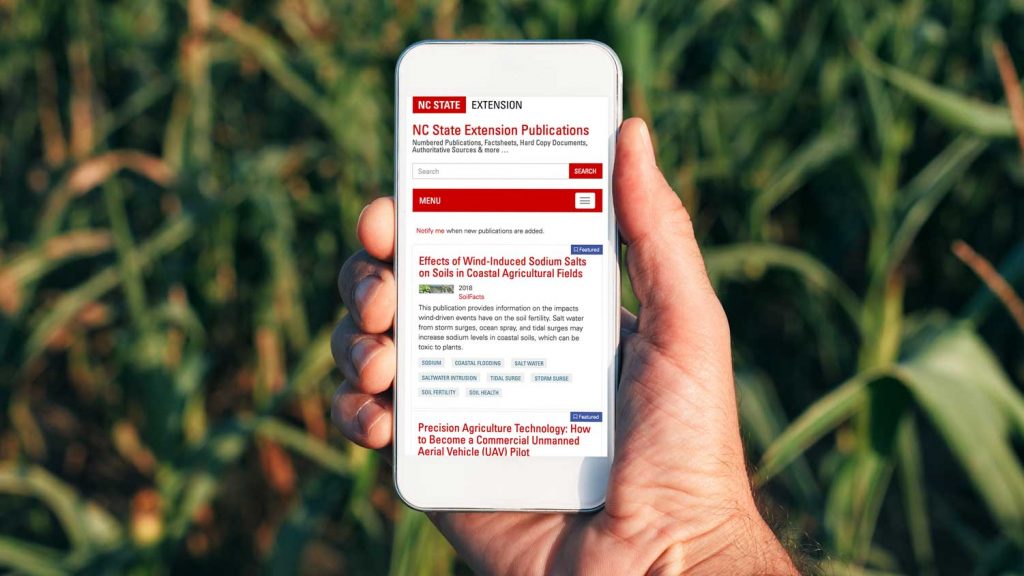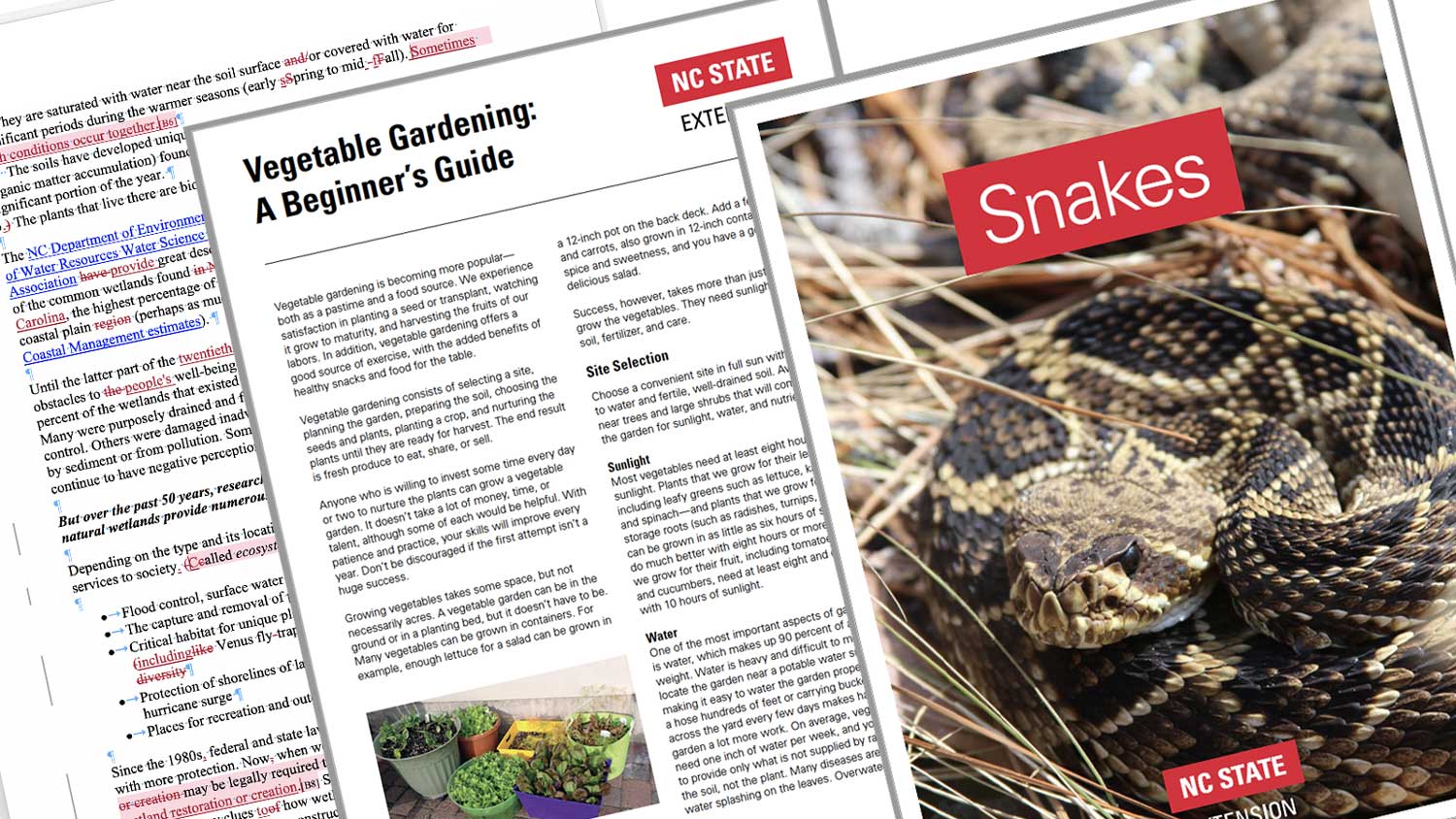Author Guidelines
NC State Extension publishes peer-reviewed publications (scholarly publications) and non-peer-reviewed publications (departmental fact sheets). All Extension publications are published electronically on the NC State Extension Publications Catalog.
When needed, some publications are printed commercially. CALS Communications edits and publishes scholarly publications produced by Extension.

- What is an Extension Publication?
- Extension Publication Categories
- Extension Publications Review and Approval (EP3) Process
What is an Extension Publication?
Peer-Reviewed Publications
Scholarly NC State Extension publications (also known as “numbered publications”) are peer-reviewed bodies of work that present original, research-based material addressing emerging and needs-driven topics that aren’t already addressed in the NC State Extension Publications Catalog. These publications are not limited to a specific length, but the length should be appropriate for the topic of the publication and the audience. Scholarly publications may be brief fact sheets, brochures, or comprehensive production guides.
Peer review allows other experts within the field to review your publication and verify information. Peer-reviewed publications are often of higher quality, are better respected, and add to a reliable body of knowledge. Scholarly Extension publications are considered scholarly products for faculty promotion and tenure. All scholarly publications must be submitted through the publications approval process (EP3) and be edited by the publications editor in CALS Communications. They receive a unique publication number starting with a two-letter prefix followed by a number.
Non-Peer-Reviewed Fact Sheets
Publications produced by Extension that are not peer-reviewed are considered to be departmental fact sheets. These publications do not need to go through the publications approval process or be edited by the publications editor; contact your department Extension leader or department head to find out the approval process for non-peer-reviewed publications in your department. Fact sheets can be entered directly into the NC State Extension Publications Catalog.
Extension Publication Categories
NC State Extension uses the following categories to help identify different types of scholarly publications. The definitions provided below help authors determine how best to present their information to a target audience and how to categorize the resulting manuscript when submitting it for peer review.
Manuscripts that pass peer review and complete the publishing process can be considered as scholarly products for promotion and tenure.
Scholarly Publications and Fact Sheets
Scholarly publications and fact sheets are brief technical communications that address a fairly narrow topic. They are suitable for a general audience and may fit into a topic-specific series. Most Extension publications will fall into this category.
Extension Manuals
Extension manuals (also referred to as handbooks or guides) are comprehensive collections of information providing in-depth analysis and recommendations related to complex topics. Care should be taken to justify why a large and detailed publication is necessary. (Examples include the North Carolina Agricultural Chemicals Manual and Cotton Information.)
Technical Bulletins
Technical bulletins are approved and their publication is funded by the North Carolina Agricultural Research Service. Information on these publications is currently under review.
Editing and Design

Extension Publications Review and Approval (EP3) Process
Criteria for Scholarly Publications
Materials that are designated as NC State Extension peer-reviewed scholarly publications meet the following criteria:
- Based on research and provide unbiased information
- Written for a general audience and present applied concepts
- Address and respond to identified needs* relevant to current or planned Extension program areas
- Applicable statewide, within a particular state region, or within identified clientele groups
- Provide new knowledge or present existing knowledge from an innovative perspective or in a new way
- Cover a topic in-depth
- Reviewed by peers and colleagues and incorporates their comments when appropriate
*Identified needs may be emerging topics known to faculty, federally-defined needs, or industry needs. Not all needs must be identified through Extension agents or local needs assessments to be considered valid topics for Extension to address.
Submission of Content and Peer Review Process
- Peer Review. Authors must submit the manuscript for peer review. (This process is currently handled by the department. Contact your department Extension leader for details.)
- Submit EP3 Request. When the peer-review process and department level approvals are complete, the department Extension leader then submits the revised content for approval by the Extension deputy director via the online EP3 Request System. (Technical bulletins must be submitted to the NC Agricultural Research Service for approval.)
- Editing and Production. When the publication is approved, the EP3 Request System will automatically notify the publications manager in CALS Communications of a pending publication request. The editor will contact the author to discuss publication requirements and details. Please allow a minimum of six weeks for editing, design, and publishing. The post-review editing and design may take longer depending on the number of pages and number of projects on the publications job list.
- Publish. When the publication is finalized, the publications editor will publish the publication to the NC State Extension Publications Catalog and provide the URL to the author. All Extension scholarly publications are published to the NC State Extension Publications Catalog in a mobile-friendly, printable web format.
WAIVER REQUEST FOR PEER REVIEW
Materials that have already undergone rigorous review through another avenue do not necessarily need to go through this process. For example, content produced through a multi-state or multi-organizational effort or content produced at the national level would not require additional peer review through this process.
To publish content already peer-reviewed through another avenue, request a waiver of review through your department Extension leader.
The peer-review requirement is waived for minor revisions to existing publications. See the Revisions section below.
Revisions
Authors are expected to keep their content current and up-to-date. The publications database will automatically notify a publication’s contact person five years after the publication date. At this point, a decision should be made to update/revise the publication or retire it. Content with an existing Extension publication number will keep the original number. Authors must submit revisions as follows (see the EP3 Request Decision Guide):
- If the revised publication has the same senior author:
- Minor revisions that do not substantially change recommendations or accepted practices do not need to go through the peer-review process and can submit a Minor Revision Request. Examples of minor revisions could include updating dates or dollar amounts, updating tables or data, updating website URLs, correcting contact information, formatting changes, or conversion from print to web.
- Major revisions that substantially change recommendations or accepted practices must meet the new guidelines for peer-reviewed content and follow the process above to submit for EP3 approval. Previously published content will be evaluated according to the new guidelines.
- If the revised publication has a new senior author:
- Minor revisions, such as date changes, grammatical edits, or conversion from print to web, do not need to go through the peer-review process and can be submitted via a Minor Revision Request.
- Any other revisions must meet the new guidelines for peer-reviewed content and follow the process above to request EP3 approval. Previously published content will be evaluated according to the new guidelines.
NOTES:
- In all instances, the term “author” can be any NC State Extension faculty member. “Authors” refers to both the primary author who generally writes most of the material and co-authors who provide a more supporting role. Authors make a significant contribution to the writing of the current version of the publication, which may include writing all or part of the manuscript and providing critical and creative review and subsequent revisions. Updated publications with new authors should state that the current version is a revision of a previous publication and acknowledge the previous authors in a footnote.
- In all instances, the term “department head” refers to the author’s unit leader. In the case of faculty who are not attached to an academic department, the unit leader is the appropriate Extension Associate Director. In the case of Extension field faculty, the unit leader is the appropriate County Extension Director or District Extension Director.